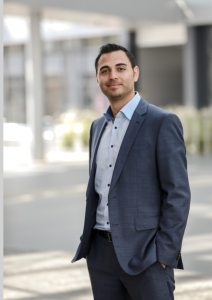With the AI transformation and structural change, the Rhineland region is developing into a digital hub in the heart of Europe. Hyperscale projects and new digital park areas mark the beginning of this transformation, which participants at the eco event "Structural Change & Digital Transformation in Three Perspectives" on September 12, 2025, in Bergheim can experience firsthand, including on a bus tour. Emil Issagholian knows what role the energy infrastructure plays in this. He is Head of the Energy Services division and District Heating at RheinEnergie and describes how the energy service provider is witnessing and shaping developments on the ground.
How significant are regional strengths and local roots when it comes to developing modern energy supply? And how do these qualities relate to RheinEnergie’s nationwide operations?
Our roots have been in Cologne and the Rhineland for over 150 years. There we are firmly anchored as a reliable partner for local authorities, municipal utilities and companies. Our nationwide engagement builds on this regional strength: with the RheinEnergie brand – namely, next energy solutions – and our wholly-owned subsidiary AGO GmbH in Kulmbach, we implement sustainable energy solutions throughout Germany.
Over 600 projects nationwide show: local roots and national innovative strength are not a contradiction, but our success model for the energy transition. Particularly in the data centre sector, our energy solutions are essential for making these projects feasible at all.
How can electricity supply in a region such as the Rhineland be planned to reliably cover both current demand and the requirements of large, rapidly growing customers such as hyperscalers?
Electricity demand from data centers – especially hyperscalers – is growing rapidly and often much faster than grid expansion can keep up. In Germany, a regular grid connection can easily take 15 years. Many data centre projects don’t have that kind of time.
Our answer to missing Internet connection is “on-site generation”. This involves locally generated energy directly on the data centre site – for example, through combined heat and power plants or fuel cells. These decentralised systems relieve the public grid, enable rapid supply security and simultaneously offer high efficiency.
As a contractor, we take care of the planning, financing, construction and operation of such solutions – including integration into existing systems. This is what makes data centre projects in regions with limited grid capacity feasible in the first place – and at the speed demanded by the market. For the Rhineland region, support through on-site generation can therefore be critical in order to assert itself as a competitive location for data centres.
Cooling and waste heat utilisation are central topics in data centre infrastructure. What innovative approaches do you see here? And how do sustainability goals come into play?
Data centres generate enormous amounts of usable waste heat – individual sites could theoretically supply entire cities with heat for a year, thus playing a central role in the heating transition.
The German Energy Efficiency Act mandates, depending on the year of commissioning of the data center, that 10-20 per cent of waste heat must be utilised. RheinEnergie creates the relevant feasibility studies and directly supports technical implementation.
At the same time, we focus on the intelligent use of the waste heat generated for self-cooling – for example, through absorption chillers, which significantly reduce electricity consumption for cooling and thus improve the data centre’s PUE value (“Power Usage Effectiveness”). In this way, a by-product becomes a real driver of efficiency.
Digital infrastructure projects can have an impact far beyond technology. What effects do you expect on the labour market, regional development and supra-regional cooperation?
The structural change in the Rhineland mining region is one of Germany’s largest regional transformation tasks. With the coal phase-out by 2030, new economic impetus is needed. Data centres can play a key role here – after all, the region offers very good location conditions in terms of connectivity and labour density, for example.
At the same time, data centres are not purely electricity consumers, but can act as energy hubs: they generate usable waste heat, are innovation drivers, and provide links for other industries. For example, energy-intensive, heat-using companies such as vertical farming businesses can locate themselves in the vicinity – with short distances, high supply security and lower energy costs. This creates new clusters that combine regional value creation, jobs and sustainable infrastructure. The role of location policy, which promotes settlement accordingly, is crucial here.
What best practices from previous projects – whether in data centres, energy supply or neighbourhood solutions – can be transferred to new digital locations, and what important lessons have you learned from them?
A good example is our current large-scale project in the new Rondorf Nord-West district in Cologne. Here, we are implementing a cold local heating network based on groundwater and heat pump technology. The system uses the groundwater from the Hochkirchen waterworks, which maintains a constant twelve degrees Celsius year-round, as a stable heat source for highly efficient heat pumps in individual buildings. These experiences can be directly transferred to data centres – for example, through integration into local heating networks or utilising the waste heat for adjacent neighbourhoods. Data centres can thus supply entire neighbourhoods or industrial companies with heat.
Our conclusion: data centres can be far more than digital infrastructure – they can become drivers of the energy transition. A holistic approach that considers energy, heat, location policy and technology from the beginning is crucial.




